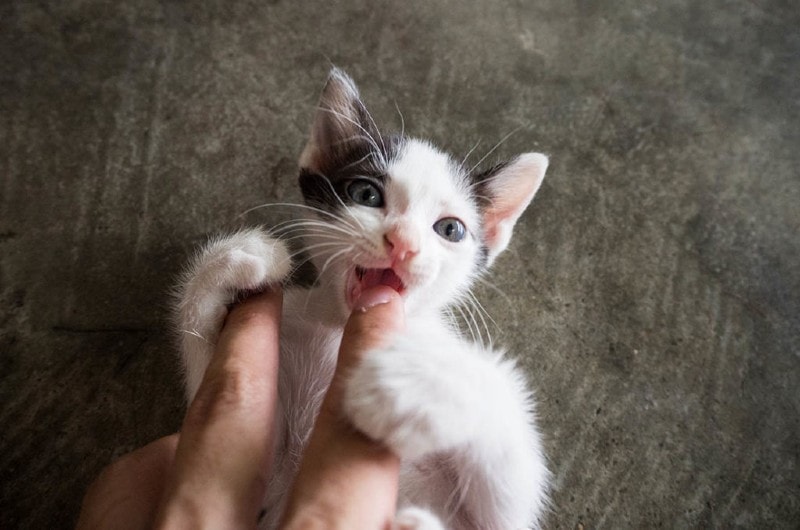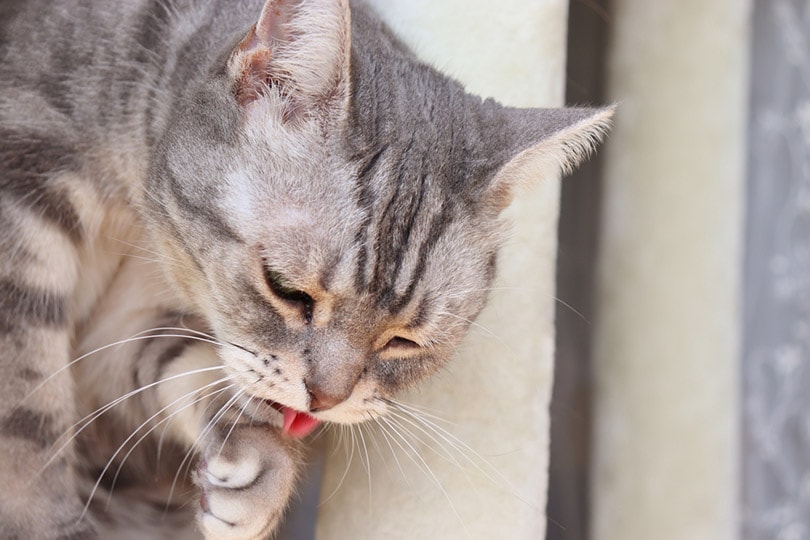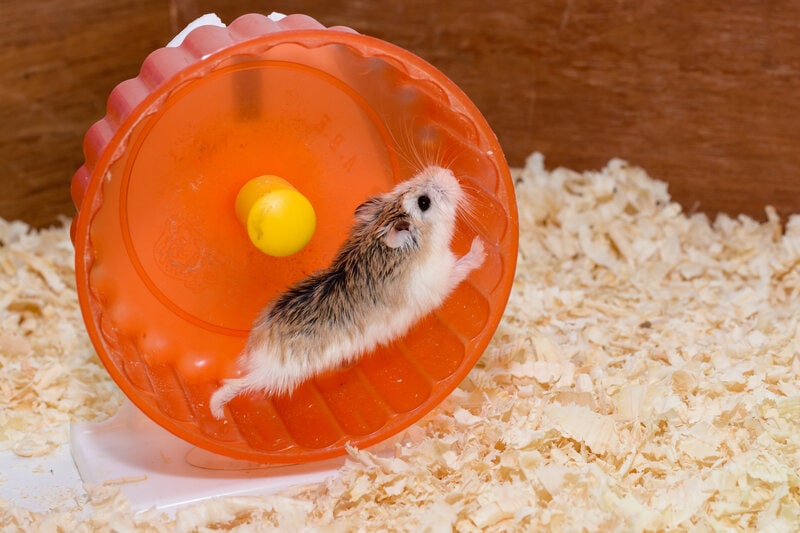VET APPROVED

The information is current and up-to-date in accordance with the latest veterinarian research.
Learn more »Click to Skip Ahead
If you have just brought home a kitten, you are hyped to be the best pet parent in the world. But what do you do if all your new pet does is bite and scratch?
Although kitten aggression may not always be aggression in the true sense of the word, it’s best to nip the behavior in the bud before it goes from bad to worse. Kittens first start playing from two weeks of age, with the behavior becoming more frequent from four to five weeks. They will learn a lot from their mother and siblings, and early socialization over the first two months of life is crucial in setting a good example. If you have a lone kitten, they can show what seems like aggression because that’s a part of their normal play behavior and learning hunting skills, and they may not know that bites and scratches should not be directed toward humans.
Read on to learn why your kitty can change from a cuddly pet to a wolverine in seconds. We will also share some practical tips to help address the behavior.

Why Is My Kitten So Aggressive?
Kittens are playful creatures, and what may seem like aggression is generally just a normal part of development. Once they start biting and play fighting from only a few weeks of age, the behavior continues as a part of learning how to interact with other felines and hunt for prey. Pouncing and grabbing hold of each other, as well as biting and scratching their siblings are ways to practice these valuable skills, teaching each other how much is tolerable and when they’ve overdone it. The queen will also play an important role here in stopping their excessive and rough biting and giving them warnings.
In the ideal setting where a kitten remains with their mom and siblings, they will experiment with the use of their “fangs” and claws with their immediate family. This is why it’s generally recommended to adopt a pair of kittens instead of one. The two will teach each other important lessons, like how much force they should put in bites or scratches. But another important aspect is never using fingers and hands to play with your kitten. As cute as it may seem in the very beginning when they can’t do much damage, but they will soon associate this with playtime and may not develop adequate inhibition, with such behavior continuing into adulthood. This habit can then be harder to break.
So, why is aggressive behavior a normal part of development?
Cats are natural predators and use their teeth and claws for hunting, killing, and shredding their catch. They have strong hunting instincts that help them survive in the world. It’s only natural for them to experiment with their “hunting gear” and want to bite and scratch things.
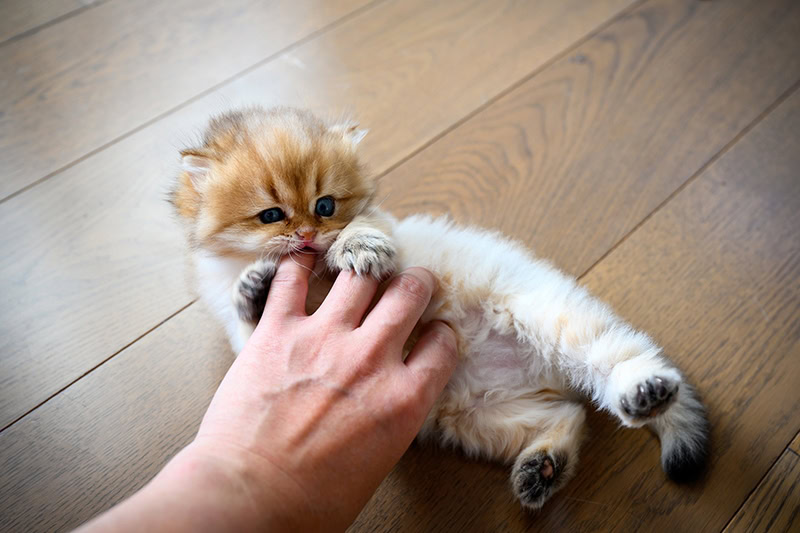
 What Does Kitten Aggression Look Like?
What Does Kitten Aggression Look Like?
There are two main reasons why kittens can be aggressive. The most obvious reason is they want to play. If you have seen your cat randomly attack your shoe, wrestle with it, and bite into the leather, they are probably just being playful.
Kittens can also show fear-induced aggression as a result of inadequate socialization, exposure to unfamiliar stimuli, new environments, and even new experiences that may be frightening. This type of aggression looks somewhat similar to play aggression but it generally doesn’t occur during typical playtime. You may notice a display of other behaviors like hissing, flattened ears, and dilated pupils. The kitten may be more shy or easily startled, and may run off and hide if hears any sudden noise or sees unfamiliar people or objects. Even familiar people may be frightening if they approach the kitten from behind or above. Many kittens that have not been properly socialized during the first two months of life may not be used to being picked up or handled as much and may hiss, scratch or bite when being picked up or petted.
Let’s look into potential types of aggression in more detail.
Play Aggression
The most common type of aggression displayed by kittens is play aggression, which is more of a rough and inappropriately directed play than genuine aggression. Kittens are naturally quite playful and energetic. If they are not raised with littermates or are weaned early and lack adequate play opportunities and teachings from their mother, or if they haven’t been properly socialized with humans or have been taught to play with human hands (and toes), they can get too excited during play sessions and lack recognition of when it’s becoming too rough.
Generally, kittens love rough play. This, combined with their hunting instinct, makes it pleasurable for them to spend hours stalking, pouncing, biting, and clawing at everything, including their owners.
You may unknowingly reinforce the behavior by playing roughly with your pet, using your hands and fingers, and even offering treats after your sessions. This will only encourage them to stalk and pounce on your fingers and toes without warning the next time they want to play. Typically, kittens raised with their siblings and mother learn not to bite and scratch too hard because their littermates retaliate or stop playing if hurt.
Unfortunately, a lone kitten or one weaned too early cannot learn from their mom or littermates. You must actively master your kitten’s patterns and address play aggression without instilling fear or anxiety.
Fear Aggression
Kittens can also display fear aggression in response to an unfamiliar stimulus. They may even perceive petting or other forms of human touch as potentially threatening stimuli. Common signs of fear-based aggression include hissing, dilated pupils, flattened ears, bared teeth, arched back, and a tucked tail.
Unfortunately, fear-induced aggression is a sign of stress and anxiety. It indicates that your cat finds a specific stimulus unpleasant or frightening or associates it with a negative experience. Depending on the degree of threat perceived, they could take flight, freeze, or attack.
 Rough Play vs Play Aggression: What’s the Difference?
Rough Play vs Play Aggression: What’s the Difference?
All kittens love rough play. Although rough play and straight-out aggression may seem similar, there’s a fine line between the two. While the former is okay as long as it’s under control, the latter must be addressed before your kitten turns into an adult cat.
Rough play involves pouncing and hopping around, often with an arched back. Some kittens may also try to grab your ankle, scratch, or bite your toes and hands, particularly if they have been playing like this since day one and have learned that your fingers are okay to bite. This is the time to act and redirect their energy towards toys and not your body parts, but we’ll get into more details about this next. Most kittens don’t break the skin when they play-bite like this, but it can easily lead to injuries if this pace of play continues.
On the other hand, kittens exposed to a stressful or frightening event will keep their ears low down, have a tense body and tail tucked in, may hiss or growl, and will attempt to escape unless they feel cornered.
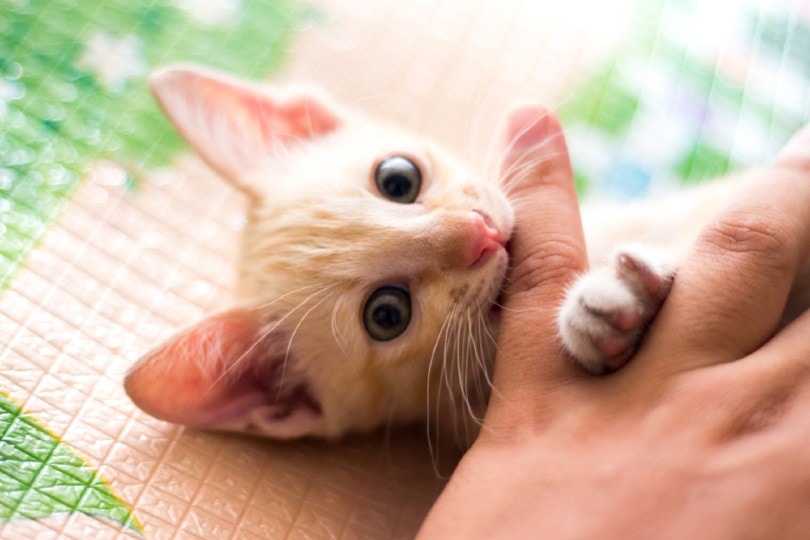
The 5 Tips to Help Stop Kitten Biting and Aggression During Rough Play
Aggression is any form of threatening behavior towards humans or other animals. Although your kitten’s rough playing is often not caused by innate aggression and a kitty’s scratch or bite will not kill you, it can lead to pain, injury, and even the risk of infection. Generally, aggressive behavior is not something you can take lightly, lest it blows out of proportion.
Here are a few tips to help you diffuse or stop kitten aggression.
1. Identify and Avoid Triggers Where Possible
If your cat gets aggressive during playtime, stop playing with them, ignore them or even go to another room to ensure your pet understands that playing aggressively only deprives them of attention.
On the other hand, you should be more patient when dealing with fear-induced aggression. In this case, identify the triggers and understand your kitty’s tolerance level to unwanted stimuli. Also, determine the reactive distance to stimuli like loud noises or other pets.
Depending on what works, remove fear aggression triggers, or increase the distance between them and your kitten. You can then slowly work towards desensitizing your cat against the things that make them fearful. When dealing with stimuli that cannot be avoided, consider implementing strategies to calm your pet down and seek the help of a feline behaviorist.
2. Help Your Cat Calm Down
One of the surest ways to make your cat calm down is to ensure they have a safe space they can call their own. Even a cat tree can suffice and act as a haven they can retire to when stressed or overwhelmed. You could also consider using cat pheromones to help reduce anxiety and stress-related behaviors.
Most importantly, react to your kitty’s fear aggression like a pro. Respond calmly and do not yell or punish your pet because this will only worsen their aggression.
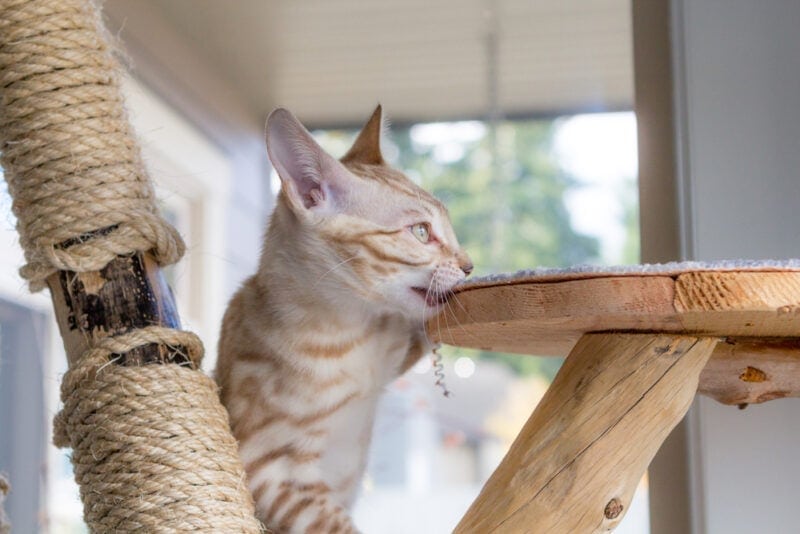
3. Use Positive Reinforcement Training
Positive reinforcement training generally involves rewarding good and desirable behavior. First, let your kitten play with you using solely toys, provided they remain gentle. Secondly, give your cat a time-out and stop playing or ignore them when they show signs of play aggression.
The third step is to offer another play session. After a minute or so of desirable play, offer a reward if your cat doesn’t use their teeth or claws. Be consistent, and don’t inadvertently reward bad behavior.
Consult your veterinarian if you would need some good advice or training tips.
4. Try Structured Playtime
Another practical tip is to create a playtime schedule. Kittens need multiple short bursts of playtime daily, depending on their age. Schedule to play with your cat at specific times of the day for 10 to 15 minutes per session.
During your play sessions, get creative and use a range of toys, including interactive toys, puzzles, or even catnip toys. Even kittens love predictable routines and are likelier to behave desirably if they look forward to spending time with you.
5. Redirect Unwanted Behavior
It is perfectly okay to help your kitty maintain the desired behavior. You can do so by redirecting aggression before it happens.
For instance, start your play sessions with a variety of toys. Switch to something that doesn’t involve your pet playing with your hands or close to you when you see signs of play aggression. This will help them differentiate your hands from toys they can stalk, bite and scratch.
If your kitty is an ankle grabber, have a toy at hand when walking around your home. Toss the toy a few steps ahead of you to distract your pet and dissuade them from attacking your feet.
The Hepper Hi-Lo Cat Scratcher features a modern and clever design that offers cats an appealing place to scratch – and a way to keep them from scratching all the things they shouldn't. Unlike most cat toys (where your cat probably just prefers the cardboard box they came in), cat's flock to this design ... maybe it's because there's cardboard in it!
With its 3-position setup, textured cardboard, and sturdy frame, it encourages their natural scratching behavior, steering them away from clawing at items like furniture, walls, carpets, curtains, and people. The Hi-Lo is a reliable solution to safeguard your home and create a more enjoyable environment for your cat, all while looking modern and stylish. At PangoVet, we've admired Hepper for many years, and decided to take a controlling ownership interest so that we could benefit from the outstanding designs of this cool cat company!

Final Thoughts
Have you seen your kitty hide behind furniture and wait until you walk by before they dash out and attack your ankles? Although it may seem funny, this nasty behavior is better off addressed before it gets out of control.
Fortunately, it is possible to fix play aggression in kittens, provided you identify the concern early and proactively address it. Apart from the above tips, it’s always a good idea to talk to your vet or a licensed animal behaviorist for personalized advice.
Featured Image Credit: XINN, Shutterstock
